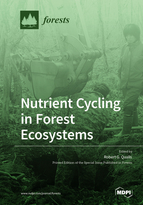Nutrient Cycling in Forest Ecosystems
A special issue of Forests (ISSN 1999-4907). This special issue belongs to the section "Forest Ecology and Management".
Deadline for manuscript submissions: closed (30 November 2019) | Viewed by 50585
Special Issue Editor
Interests: forest biogeochemistry; wetland biogeochemistry; succession and ecosystem development; effects of climatic warming and CO2 fertilization on forest soils; soil organic matter chemistry; microbial ecology; chlorine chemistry in water; ultraviolet light disinfection
Special Issues, Collections and Topics in MDPI journals
Special Issue Information
Dear Colleagues,
The long term productivity of forest ecosystems depends on the cycling of nutrients. In fact, the carbon dioxide fertilization effect on forest productivity may ultimately be limited by the rate of nutrient cycling. Contemporary and future disturbances such as climatic warming, deforestation, short rotation sylviculture, fire (wild and controlled), and the invasion of exotic species all place strains on the integrity of this system of nutrient cycling. Global differences in climate, soils, and species make the extrapolation of even a single important study difficult to extrapolate to forests worldwide. Despite advances in the understanding of nutrient cycling and carbon production in forests, many questions remain. These questions are reflected in the topics listed below. We invite submissions for a Special Issue of Forests on the subject of “Nutrient Cycling in Forest Ecosystems”. Topics for submissions may include, but are not limited to:
- forest nutrient stocks and climate change;
- ability of increased N and P mineralization caused by soil warming to sustain increased productivity caused by CO2 fertilization;
- uptake, removal from soil, and cycling of nutrients during forest growth (either natural ecosystem development or growth of managed forests);
- nutrient cycling and species diversity: does increased tree diversity improve nutrient use in plantations?
- species effects on nutrient cycling; dominant species traits that affect nutrient cycling;
- effects of invasive species or forest management practices on nutrient cycling;
- genomics of microorganisms involved in nutrient cycling;
- role of mycorrhizae in nutrient cycles;
- fate of nutrients used in fertilization;
- root productivity and nutrient turnover;
- fundamental mechanisms that control P cycling in tropical forests;
- causes of recalcitrance in soil organic matter mineralization.
Prof. Dr. Robert G. Qualls
Guest Editor
Manuscript Submission Information
Manuscripts should be submitted online at www.mdpi.com by registering and logging in to this website. Once you are registered, click here to go to the submission form. Manuscripts can be submitted until the deadline. All submissions that pass pre-check are peer-reviewed. Accepted papers will be published continuously in the journal (as soon as accepted) and will be listed together on the special issue website. Research articles, review articles as well as short communications are invited. For planned papers, a title and short abstract (about 100 words) can be sent to the Editorial Office for announcement on this website.
Submitted manuscripts should not have been published previously, nor be under consideration for publication elsewhere (except conference proceedings papers). All manuscripts are thoroughly refereed through a single-blind peer-review process. A guide for authors and other relevant information for submission of manuscripts is available on the Instructions for Authors page. Forests is an international peer-reviewed open access monthly journal published by MDPI.
Please visit the Instructions for Authors page before submitting a manuscript. The Article Processing Charge (APC) for publication in this open access journal is 2600 CHF (Swiss Francs). Submitted papers should be well formatted and use good English. Authors may use MDPI's English editing service prior to publication or during author revisions.
Keywords
- Forests
- Biogeochemistry
- Nutrient cycles
- Soil
- Climate change
- Nitrogen, phosphorus, carbon, micronutrients






